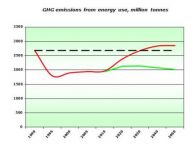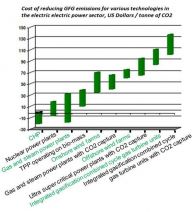Main » Greenhouse gas emissions
Greenhouse gas emissions
ERI RAS continuously tracks trends in greenhouse gas emissions from fossil energy use as part of its work on the national and regional fuel and energy balances and fuel and energy sector development forecasts. This enables to study possible scenarios for the development of the Russian energy sector, taking into account a reduction in carbon intensity of the economy, assess the contribution of energy efficiency measures to the final demand and in the fuel and energy industries. It is also possible to evaluate how the rate at which low-carbon and non-carbon technologies are being developed impacts on curbing GHG emissions. Data produced by ERI RAS on the predicted level of GHG emissions is regularly used in the preparation of “National ommunications of the Russian Federation”, officially presented in accordance with Articles 4 and 12 of the United Nations Framework Convention on Climate Change and Article 7 of the Kyoto Protocol.
Considering the limited term of action of the Kyoto Protocol and the beginning of the active phase of an international discussion on the parameters of post-Kyoto climate change obligations, ERI RAS has for several years been conducting consistent and integrated research to elaborate on the scenarios of a more active policy to curb GHG emissions in Russia for the period up to 2050. Possibilities and consequences of a more intensive improvement in the efficiency of consumption and conversion of fuel and energy resources and the development of non-fuel and low-carbon energy sector are determined at the level of the industries in the fuel and energy sector and the economy as a whole. Various economic mechanisms of regulating emissions, including charges on GHG emissions, and options for the structuring of the carbon market are taken into account.
 The emphasis in this research is placed on the contribution of the electric power sector to the development of new trends in GHG emissions. The electric power sector in Russia is the largest internal consumer of fossil fuels and currently produces around 30% of national GHG emissions. At the same time this sector has a vast potential for changing the structure and efficiency of use of various types of energy resources by introducing new technologies in heat generation and developing non-fuel generation (nuclear power and hydro power generation, renewable energy sources). The following tasks are jointly resolved in the course of the research:
The emphasis in this research is placed on the contribution of the electric power sector to the development of new trends in GHG emissions. The electric power sector in Russia is the largest internal consumer of fossil fuels and currently produces around 30% of national GHG emissions. At the same time this sector has a vast potential for changing the structure and efficiency of use of various types of energy resources by introducing new technologies in heat generation and developing non-fuel generation (nuclear power and hydro power generation, renewable energy sources). The following tasks are jointly resolved in the course of the research:• Forecasting technical and economic performance indicators and estimating comparative effectiveness of low-carbon and non-carbon technologies (using unit costs of the volume of reduced emissions).
• System optimisation of the structure of generating capacities and electricity generation given various scenarios of economic stimulation of such technologies. The dynamic model for the development of the electric electric power sector within the fuel and energy sector (EPOS) is used. (ссылка)
• Estimates of additional increases in necessary investment and electricity prices required to implement less carbon intensive electric power sector development scenarios.
 A macroeconomic assessment makes it possible to determine quantitative parameters of scenarios for curbing GHG emissions in Russia and to evaluate their long term impact on economic growth and the structure of the Russian economy. A special version of a non-linear inter-industry model for the development of the electric power sector within the economy was developed at ERI RAS specifically for this purpose. (ссылка) This model reviews various carbon intensive industries within the electric power sector: the metallurgical industry, the petrochemical industry and production of other non-metallurgical mineral products (construction materials).
A macroeconomic assessment makes it possible to determine quantitative parameters of scenarios for curbing GHG emissions in Russia and to evaluate their long term impact on economic growth and the structure of the Russian economy. A special version of a non-linear inter-industry model for the development of the electric power sector within the economy was developed at ERI RAS specifically for this purpose. (ссылка) This model reviews various carbon intensive industries within the electric power sector: the metallurgical industry, the petrochemical industry and production of other non-metallurgical mineral products (construction materials). The approach used by the Intergovernmental Panel on Climate Change (IPCC) is used as the methodological basis for research. The model covers all types of anthropogenic greenhouse gas emissions, including the following:
- GHG emissions from use of fuels in various sectors of the economy;
-Fugitive emissions) – GHG emission from production and transportation of coal, oil and gas (including emissions from flaring)
-GHG emission from industrial use of non-fuel mineral resources (production processes separately for the construction, the petrochemical and the metallurgical industries);
-GHG emission in agriculture;
-GHG emissions from waste in the industry and the public utilities sector.
In the last few years the results of the research were widely presented at international conferences and publicised in foreign and Russian journals.
Research in this direction is conducted by the following departments:
-Department (Laboratory) for Studies in Energy Economics (Head of department – V.A. Malakhov, Ph.D. in Economics
-Department for electric power sector development and restructuring (Head of Department - F.V. Veselov, Ph.D. in Economics






